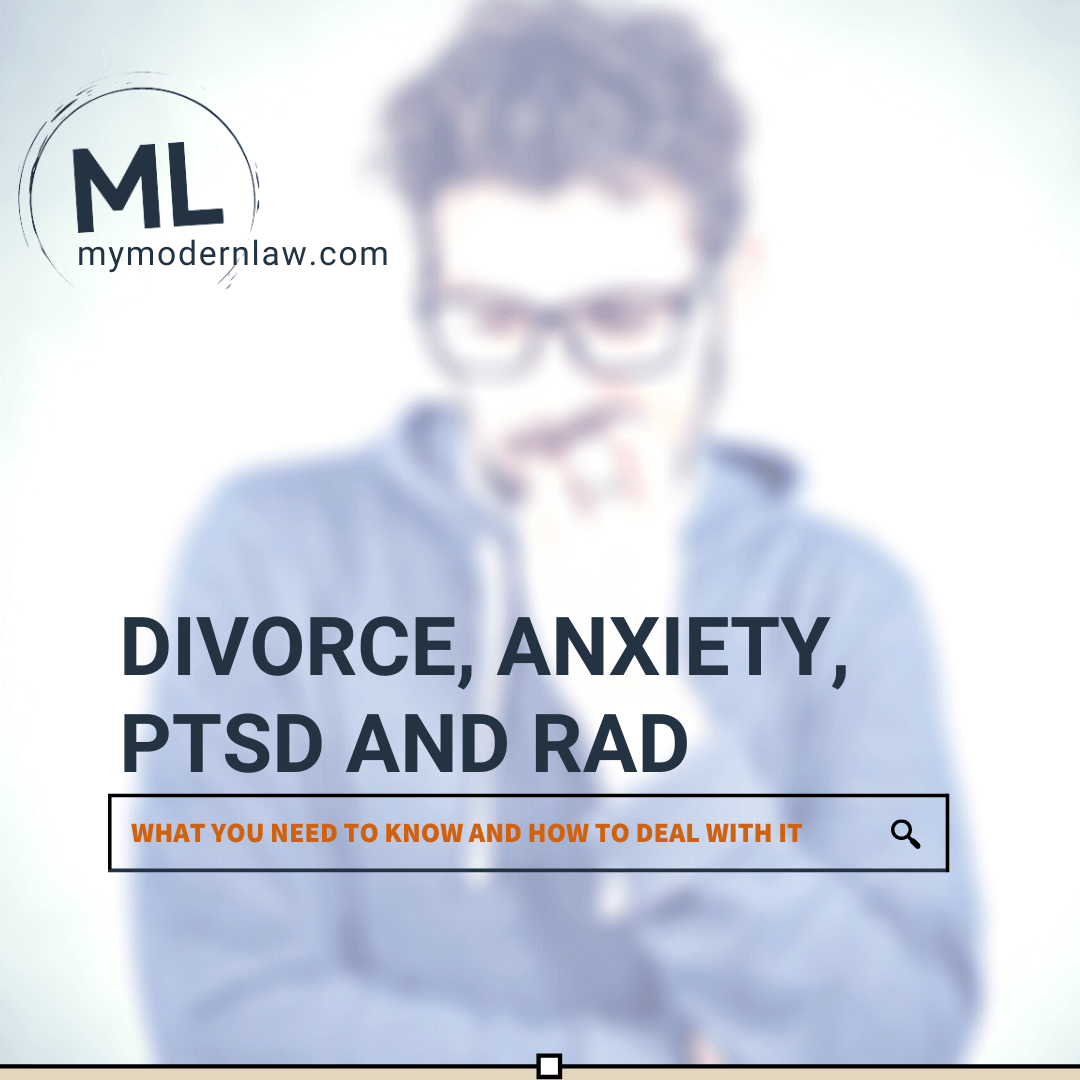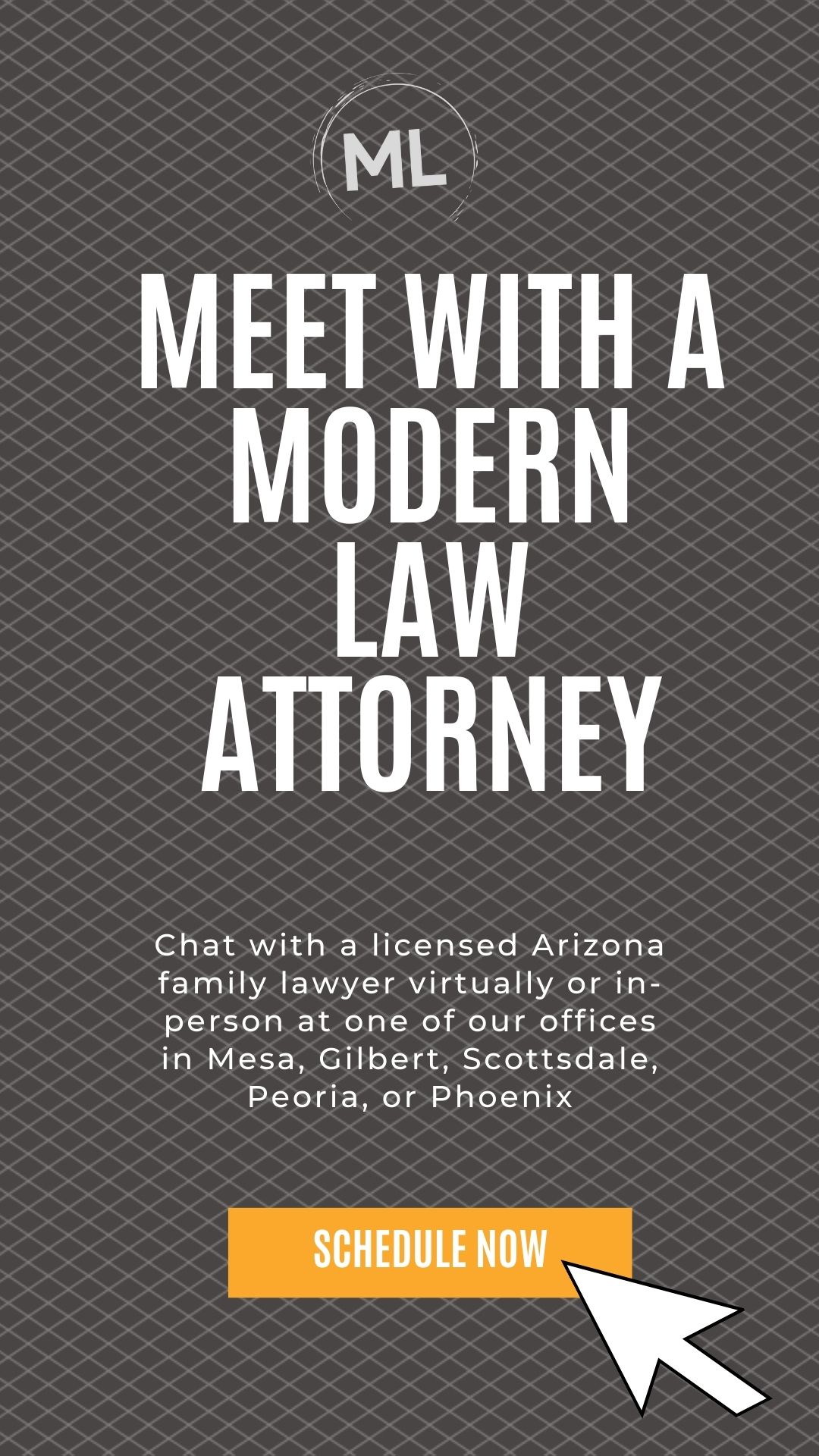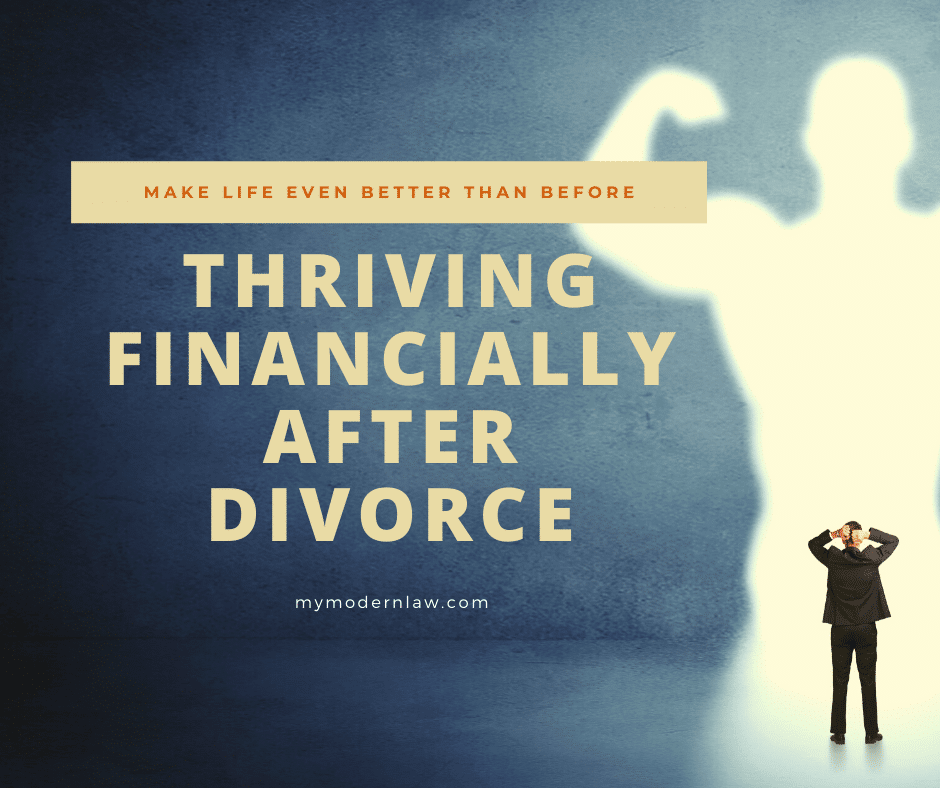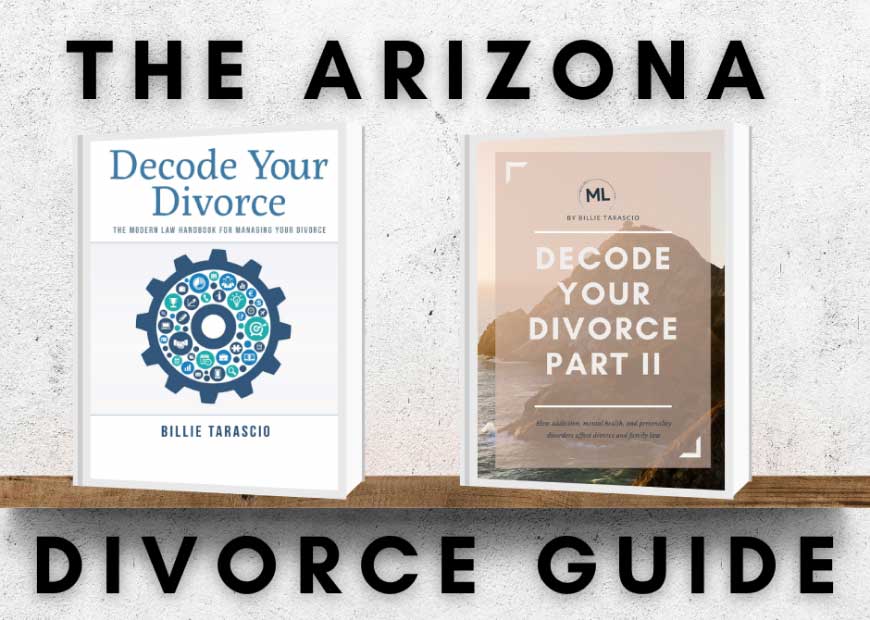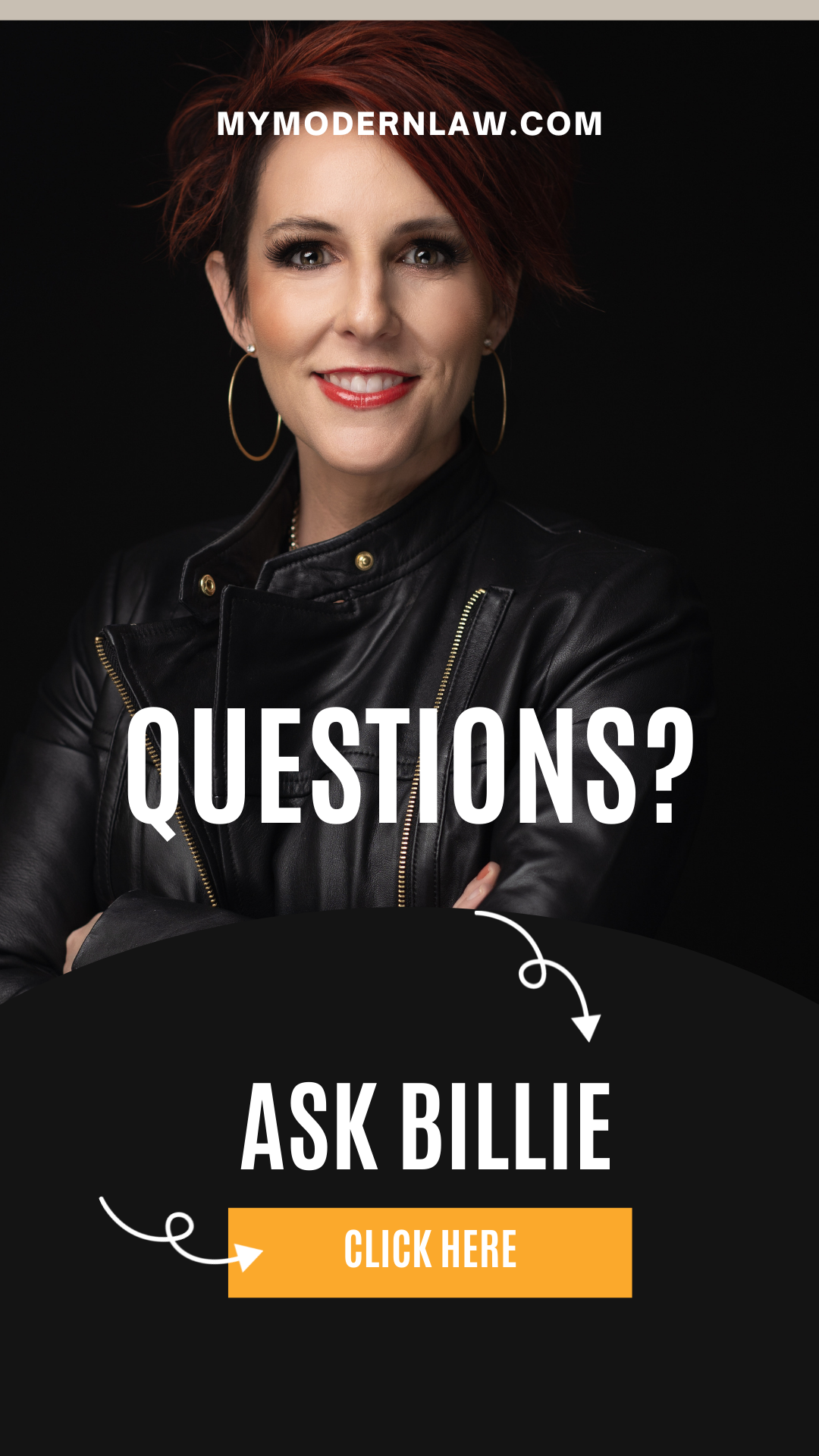Divorce and Anxiety, PTSD, and RAD
Another common group of mental health conditions that have an impact on divorce and custody, and vice versa, are anxiety, PTSD, and RAD (Reactive Attachment Disorder). These conditions cause a number of different symptoms and when one or both partners struggle with them, it can make the entire process of divorce more difficult for everyone involved.
Anxiety is a general term that refers to several different specific conditions that include things like panic disorder, social anxiety, generalized anxiety, PTSD, and others. PTSD is a condition all its own, but it is also sometimes included under the anxiety umbrellas because it is so similar in the symptoms and treatment or management of the condition.
When someone feels the symptoms and feelings related to these conditions, they are often stressed, anxious, worried, paranoid, and even sometimes totally unable to function in “normal” society. People have lost jobs and families over these conditions, and it’s not uncommon at all. Some people even lose their lives. It’s a serious issue, but it’s one that you can work through, with the right knowledge and a good plan.
Mental health issues are all around us and impact our lives and divorce and the safety of our children. In some situations you may need intervention or an order of protection.
Divorce and Anxiety, PTSD, and RAD
What are These Conditions and How are They Related?
These conditions are often lumped together because they share several symptoms. However, they also share two common feelings: panic and overwhelming fear. People with any of these three conditions have a very deep sense of fear or panic, either at all times or due to certain events or situations.
PTSD and Reactive Attachment Disorder fall under the anxiety umbrella, but they are technically classified as Trauma Disorders. Although each condition has its own symptoms and manifestation, at the root, this is what they share and why we’re discussing them together instead of creating separate chapters for each.
These conditions have several different causes, but they are all typically some form of stress response by the body, as a way of coping. In some cases, there may also be genetics or chemical imbalances at play, but there is a lot to still be understood about these conditions.
What we do know is that they can have a serious impact on personal relationships, including marriages and parenting relationships. There have been many instances where relationship issues have led to or made these conditions worse, as well. Divorce and family law issues are stressful, even when they’re amicable. It is just a difficult process to go through, emotionally and otherwise.
When you add in mental health disorders that are exacerbated by stress, you’re looking at a whole different level of complications. In order to better understand how to handle these conditions during your divorce, let’s take a little time to learn more about each of them.
Anxiety
Let’s start with anxiety. This is the biggest and most common condition in the group. Anxiety comes in many forms and can have many causes. Like many mental health conditions, there is still a lot being studied about anxiety conditions and how they come about. However, it is believed that there are genetic factors, chemical causes, and environmental factors that can all have their impact on the development or seriousness of an anxiety condition.
The most common types of anxiety conditions include:
- Generalized Anxiety Disorder
- Social Anxiety
- Panic Disorder
- Agoraphobia
- Obsessive-compulsive Disorder (OCD)
- Post-Traumatic Stress Disorder (PTSD)
- Separation Anxiety
- Other specific phobias
Anxiety conditions have a lot of different symptoms and behaviors and they typically cause people to avoid situations, people, or events that cause them undue stress. Some people will just be generally anxious all the time, which can be exhausting, to say the least.
Anxiety is basically the brain’s response to unnecessary stimuli– something, somewhere in the brain says “panic”, so it does. When the body or the environment doesn’t give it a reason to be stressed, people without anxiety will calm down. Those with anxiety will turn that panic into anxiety because they are looking for some way to expend the emotion.
This is a very complex condition and it can impact people’s lives in several different ways. The type of anxiety that a person has will also affect their treatment options and other circumstances, so it’s important to seek appropriate help and get the right diagnosis.
PTSD
Post-Traumatic Stress Disorder, or PTSD, is a condition that affects more people than we know. It is one of the most under-diagnosed anxiety conditions because a lot of people are ashamed to seek treatment in the first place. PTSD is commonly known among combat veterans and those who have lived through major traumas, but the size of the trauma doesn’t dictate whether or not you end up with this condition.
A man whose wife dies unexpectedly in her 40s, beside him in their sleep, will probably develop some PTSD for various reasons, and especially related to sleeping and going to bed.
Someone who is traumatized by the sound of gunshots won’t be able to make it through the Fourth of July without earplugs or a sleeping pill.
There are all levels and types of PTSD, and none are any more or less valid than the rest.
The important thing is to get PTSD diagnosed and treated. This cannot be done on your own and if is left untreated for too long, there may be irreparable damage caused. Long-term PTSD has actually been shown to increase the risk of suicide and substance abuse, along with other risky behaviors and lifestyles.
Post-Traumatic Stress Disorder happens when the body isn’t capable of processing the original trauma or stress. As a result, it unnecessarily responds to otherwise-safe stimuli with a panic or fear response.
People will often struggle to form or maintain personal connections, as well, which is why relationships are so affected. The incidence of divorce among those suffering from PTSD is staggeringly higher than those without the condition. It’s often hard for couples to work through trauma together, and especially if only one of them was affected.
Reactive Attachment Disorder
A more extreme symptom of PTSD for some, and a condition all its own for others, RAD is a condition where people lack the ability to connect to others or the world around them. As the name suggests, people’s brains are reacting to a situation that was traumatic, and thereby caused them to feel that it would be safer to stay detached from the rest of the world.
Until it can be proven that things are “safe”, people will not be able to form bonds or build healthy relationships, which can tear families apart.
Reactive attachment disorder affects more people than you might think, including many that have never been properly diagnosed. If you have a spouse or know someone who seems detached, “in another world”, timid and introverted, or otherwise unable or disinterested in making connections, this condition could be at play.
It often comes with PTSD and other traumatic situations, but not always. The way that it affects people varies, depending on what they have been through, but the effects are always stressful, anxiety-inducing, and often create a lot of depression and anger, as well.
Reactive Attachment Disorder is also relevant in the case of divorce and custody when it is found in children.
Children who have been neglected emotionally, physically, or otherwise could struggle to form emotional attachments with their parents or others, eventually developing this condition. It interferes with natural emotional attachment and can also affect things like stress management, positive thinking, self-love, and more. Some with this condition will react violently toward parents or other authority figures, which can become dangerous to everyone.
Children who go without having this condition treated will likely continue to experience the symptoms of the condition as adults. This can make it difficult to function on a daily basis, let alone thrive or excel.
What Behaviors are Associated with Each?
Several symptoms are shared between these conditions, although each also has its own to consider. They’re grouped together because of their likeness, after all. However, understanding the minute differences between each could also help people ensure that they get the right diagnosis. Understanding the behaviors and symptoms of these conditions is the first step in preparing for the divorce process, as well.
In this section, we’ll again go one-by-one through the conditions and list their common behaviors and symptoms so that you can have a better idea of what you may be dealing with. You can use the information as it applies to yourself or your soon-to-be ex, whatever the case may be.
Many of the symptoms and behaviors of these conditions are rooted in fear and a sense of feeling unsafe, which we’ve discussed. You can probably imagine some of the most common symptoms, even if you haven’t experienced these conditions firsthand. Of course, there are also others that are less known that might surprise you.
Then, there are those that make it easy to differentiate what conditions you are dealing with, such as the stimuli-based panic attacks often associated with PTSD. Keep reading to learn more about the behaviors of these conditions and what you should be looking for, as well as how to respond.
First up, let’s talk about anxiety.
Anxiety Behaviors and Symptoms
People with anxiety will have different specific behaviors based on the type of anxiety that they have. However, they will generally have a sense of fear and uncertainty, feeling anxious when presented with certain situations. They could worry excessively, struggle with sleeping or eating as a result, and even have difficulty functioning in everyday life.
Anxiety can manifest itself in so many ways. Some people get jittery and obviously nervous. Others get physically nauseous or develop stress headaches. Still more people might even experience fainting spells and extreme panic attacks as a result of their anxiety condition.
Some of the most common symptoms and behaviors of anxiety include:
- Agitation and irritability
- Restlessness and an inability to sit still
- Socially withdrawn or isolated
- Inability to function properly to meet responsibilities at work, school, or home
- Agoraphobia (fear of open spaces)
- Inability to perform routine tasks like personal care and daily living duties
- Increased stress levels
- Constant state of worry and panic
- Worried or stressed for “no reason”
- Feeling of helplessness or worthlessness
- Feeling in danger or despair
- Feeling detached or dissociated from the world
- Difficulty concentrating or racing thoughts
- Always fearing or thinking the worst
- Uncontrollable thoughts or obsessive thinking
Divorce and Anxiety, PTSD, and RAD
This is not a comprehensive list, of course, and there are plenty of other symptoms and signs that could point to anxiety. In fact, this list doesn’t even include any of the physical symptoms that often present in people who are struggling with some form of anxiety disorder.
That’s right– that tightening in your chest when you’re anxious isn’t a heart attack. It’s just anxiety. These conditions can cause several physical symptoms that usually only serve to make things worse because then, people worry about the physical manifestation, as well. If you or your spouse has an anxiety condition, you could experience things like:
- Shortness of breath or difficulty breathing
- Insomnia and increased tiredness
- Headaches or muscle aches
- Digestive distress, including vomiting
- Chest pain or pounding heart
- Cold or clammy hands and feet
- Dry mouth
- Excessive sweating
- Numbness or tingling in feet/hands
- Fainting
Again, this is not a full list of possible physical symptoms, but it does cover a lot of the most common ones that people experience. As you can see, there are going to be several ways that an anxiety condition and its related symptoms could affect someone’s life, including their marriage, parenting abilities, and more.
Whether you’re the one struggling with the condition or you are trying to come up with a plan to deal with your spouse’s anxiety disorder, understanding what you’re up against is the most important part.
Remember, anxiety disorders are different for everyone, so your plan for navigating them during your divorce or custody case will depend on your specific circumstances. Now that you know more about what you are dealing with, it should be easier for you to make a plan.
PTSD Symptoms and Behaviors
Divorce and Anxiety, PTSD, and RAD
PTSD is just like anxiety in that it will manifest itself in several ways. Some people have extreme anger, while others will experience deep bouts of depression. Still more will be anxious and uncertain or withdrawn and emotionally detached. Every person is different, but there are some common behaviors and symptoms that you can look for.
Of course, you’ll want to leave it to the professionals to diagnose the condition, but it is fairly safe to assume people experiencing these symptoms could be suffering from PTSD. Many people with this condition will experience anxiety, including any or all of the symptoms and behaviors listed above.
In most cases, the symptoms are intensified or more severe. Often, those who suffer from PTSD will have frequent flashbacks of the event or the moments right before or after it. On the other hand, some people will block out the event(s) entirely. Not only that, but they may also avoid situations that remind them of the traumatic experience that they had.
In some cases, they may react poorly to stimuli that remind them of the event. In the example from earlier where the husband lost his wife unexpectedly, it would be understandable if he was anxious to hear sirens or see flashing lights for a while, after having the emergency in his own home.
The difference here is that the symptoms of PTSD, unlike anxiety, are generally urgent and unexpected, very obvious, and difficult to recover from in many cases. Depending on the severity of the trauma, the severity of the symptoms could be worse for some than others.
People with this stress condition generally develop it when their body and brain feel like safety is a threat. There are several different kinds of events that could lead to this condition, but it ultimately presents itself in much the same way regardless of the root cause.
There are usually three main categories of symptoms that are used to diagnose PTSD:
- Re-experiencing traumatic events through flashbacks, nightmares, and other distressing memories or recollections.
- Emotional avoidance or numbness in regard to reminders of the trauma or event.
- Increased emotional arousal, including insomnia, irritability, difficulty concentrating, and being easily angered or irritated.
Memory loss or the inability to retain information is another common symptom of PTSD that many people don’t discuss. However, as the brain is trying to process the traumatic event, it eventually runs out of the ability to handle new information, making things like getting a job, performing in school, or even just handling daily tasks difficult.
In addition to the impact that forgetfulness and its related behaviors could have on a relationship or parenting situation, it can become frustrating for the affected person. Trying to function when your brain literally will not cooperate can be infuriating, to say the least. Because people don’t always understand this condition, however, some people feel overlooked and like no one knows what they are going through.
Thus, PTSD often leads to isolation, homelessness, and even suicide in many instances when it is left untreated or not treated correctly.
The suicide risk for people with PTSD is quite high because of the frustration, despair, and lack of available support and resources. It also increases for those who see a bigger external impact on their lives– those who lose a relationship or who are cut off from their children may be more likely to commit suicide or feel suicidal with PTSD than those who have fewer external manifestations of their condition.
Fortunately, the availability of support and resources is improving and when you work with the right legal team, you’ll never have to worry that you’re not getting the resources or assistance that you need when this condition is a part of your divorce or custody case.
Behaviors Associated with RAD
Reactive Attachment Disorder shares some symptoms with PTSD and anxiety– namely, the withdrawn, detached mode that many people fall into. Even the infants and children suffering from this condition will withdraw socially and not form emotional bonds with their families or others. They may even struggle to be emotionally and physically expressive with others or about themselves, and may act out or “rebel” as a way to try to deal with their feelings.
This condition can affect people’s ability to manage their stress and emotions and can present itself differently in adults and children. However, the basic symptoms are the same– a detached, anxious, or isolated sense of being with emotional distress or the inability to regulate emotions.
That’s a lot, so let’s break it down a little. People with RAD are detached. They don’t connect well, socially or emotionally, with peers, family, or anyone, really. They are often left to feel isolated and will hold back their emotions or avoid interaction altogether. Many people with RAD avoid physical touch and are irritable or unusually angry or sad.
People with this condition usually have behaviors and symptoms that include things like:
- Withdrawal or avoidance
- Keeping to themselves
- Indiscriminate social choices
- Inability to be comforted
- Lack of affection or not seeking affection
- No attachment to family or caregivers
- Inappropriate attachments
- A tendency to act younger or older than their age
- Tendencies to seek affection in dangerous ways
There are different types of this disorder, which is why the symptoms and behaviors seem to run the gamut. Typically, when we discuss Reactive Attachment Disorder in relation to divorce and custody situations, we’re referring to the children involved.
However, as we’ve discussed, it can affect adults also, typically when left untreated as a childhood condition. In adults, it manifests as isolation, inability to form social bonds, and difficulty in relationships, including marriage and family relationships. This can have a huge impact on any marriage and subsequent divorce.
Conversely, those who are already struggling with this condition and a failed marriage or loss of a child in a custody case could create an added sense of loss and further their attachment issues. People with this condition may see a failed marriage or custody loss as another reason to stay detached and avoid interpersonal relationships, which could impact them well into the future.
There’s still not a lot known about how this condition impacts adults because it is mostly studied in children, but as we learn more about the adults who are never properly treated and diagnosed, it becomes clear that more research is needed. For now, you’ll want to read up as much as you can, talk to your lawyer, and make sure that everyone is on the same page and ready to deal with this condition regardless of what it entails.
What Causes These Conditions?
The exact cause of every single case of anxiety, PTSD, and RAD is not known, and it may never be. However, what we do know is that several factors are involved. People often have major life events or traumas that contribute to these conditions. Some may have a genetic predisposition or they may have a chemical imbalance that also factors into play, but again research is ongoing.
It’s fairly common for therapists and other professionals to attempt to root out environmental factors that could contribute to these conditions since most are believed to have a combination of causes rather than just one. Here’s what we know about what causes these conditions to this point.
Anxiety: Besides chemical and genetic factors, there are several situations that can contribute to anxiety. Traumatic events or experiences that affect people’s feelings of personal safety or wellbeing are involved in many cases. Research tends to point to the fact that most anxiety conditions are caused by multiple factors or risks, rather than one static situation, event, or circumstance.
PTSD: While some people, again, may be more genetically or chemically inclined to develop PTSD, it typically stems from experiencing a traumatic event. Not every trauma results in PTSD and there is no real standard for what constitutes a “trauma” since everyone is different. The most familiar instances of this condition for people include those seen in veterans and people from abusive situations or relationships.
RAD: Reactive attachment disorder is believed to be largely caused by a lack of attention during infancy and young childhood. Children that are neglected or that don’t have strong parental attachments in their lives could develop this condition, causing them to struggle to form relationships for the duration of their lives if it is left untreated. Genetics and chemical issues are less at play here, although any of these could always be a contributing factor to mental health conditions, including RAD.
The Potential for Future Understanding
As research continues, we will hopefully learn more about how these conditions are caused, and therefore what can help treat them and alleviate the symptoms for people. Understanding the cause may also help salvage some relationships and save a lot of people from the risk of divorce.
Of course, for some, the knowledge of where these conditions come from could be just that: extra knowledge. But then you also have to remember that this insight could help you down the road, and even help you in setting up the best possible legal plan for handling your divorce or custody case when these conditions are involved.
How Can Anxiety, PTSD, and RAD Affect Divorce and Custody?
All of these conditions center around a couple of basic emotions or issues: fear, trust, and a general feeling of being unsafe or in danger. As such, they all have a serious impact on personal and professional relationships, including familial relations, marriages, and parenting. During your divorce or custody case, these conditions can be exacerbated, or vice versa.
People who are suffering from these conditions will struggle to develop attachments and may not feel like they can trust other people. They may struggle to be vulnerable because they feel like they can only depend on themselves, if that. These people often feel that nothing is safe, although there are milder conditions that may not be as “life or death” in their severity.
As you can guess, all of this emotional turmoil and lack of general trust in the world around them can lead these people to have a lot of different issues in divorce and custody hearings. Their inability to handle daily living could impact their ability to retain custody of the children, for example. Someone with severe PTSD may be put in a position where they are only granted supervised visits because the safety of the child is a concern.
To get a better idea, let’s take a closer look at each of these conditions separately and what impacts they may have on a divorce or custody case. Bear in mind that you’ll have to consider whether it’s yourself or your spouse that is struggling with the condition, or in the case of RAD, if the child’s welfare is a concern.
Anxiety
When dealing with anxiety in divorce and custody cases, there are so many different impacts that anxiety can have. The individual who is struggling with anxiety could be failing to function normally or be able to perform “typical” things like daily hygiene and care, working a regular job, and so forth.
If you’re the one with the condition, you need to discuss the situation with your lawyer and make sure that you follow their advice along with the recommendations of the court to present the best case possible for a fair outcome.
Anxiety can make people more edgy and irritable. It can also create added depression for those who struggle with anxiety-induced depression. Those who have agoraphobia or social anxiety disorders may struggle through the actual hearings and in-person proceedings that have to take place along the way. When left untreated and unchecked, anxiety can even become violent and sometimes angry, creating a serious emotional rift in relationships that can extend to the divorce and custody hearing.
PTSD
People suffering from PTSD can experience a range of emotions that can change on a dime. they can become violent, abusive, and even completely unable to control their emotions. This can be dangerous to partners and children alike, and in some cases, it can lead the courts to determine that the individual may not be fit to have custody.
If not properly diagnosed, treated, and documented in the legal process, PTSD can end up causing a lot of issues for people in the court system. After all, the court is looking out for the best interests of the child and when one of the parents is struggling with a disorder like this, they will usually not be the first choice.
The actual process of divorce and custody hearings can also make the PTSD condition worse for some people. it can add to their sense of failure and the “doom cycle”, showing them that their fears are somehow legitimate because their life is, in fact, falling apart just as they’d imagined. It’s almost a self-fulfilling prophecy.
Even if there are no children involved, a PTSD diagnosis could have a huge impact on the divorce process. It could be the catalyst that leads to the divorce in the first place and it could create a bigger sense of panic and dread than necessary for those involved. Some people will feel like they have “failed again” and thus feel more depressed, suicidal, or guilty about their condition and their role in the failure.
PTSD is trauma, and it’s serious trauma. Too often, people don’t talk about it and that makes some feel isolated and like they should just be able to “get over it”. That’s not how it works, though. Embracing the PTSD diagnosis, whether it belongs to you or your former partner, is the first step in navigating the waters of divorce and custody.
Reactive Attachment Disorder
As we’ve discussed, this condition is usually discussed in relation to the children involved in the case. When children are diagnosed with this condition, it can have a definite impact on the custody outcome. After all, it may be determined by the courts that the neglect of one parent caused the condition, and therefore they are not going to be a good choice for the child or children.
In some cases, the disorder may be the result of another situation or circumstance, but it could still impact the outcome of court proceedings.
In the case of RAD in children, there will typically be an assessment done to determine where the condition developed (if it can be determined) and how it is being treated or handled given the current situation. Then, the courts will decide how to proceed with custody based on the information gathered and the cases presented by parents who are seeking custody.
If there is a spouse in the relationship that struggles with RAD as a result of their own unresolved childhood issues or a rare case that began in adulthood, this can further add struggles to the divorce process because of their attachment issues, unaddressed emotions, and other symptoms and effects.
Added Stress
Of course, any and all of these conditions will add stress to a divorce hearing or custody case. This process is already a high-stress situation that alters people’s lives seriously and permanently. It’s only natural that it’s going to make people a little extra anxious and worried. Some people may experience temporary anxiety or depression just because they’re getting divorced, even.
When you are dealing with any of these conditions and trying to get through a custody or divorce case, you could feel like the odds are stacked against you. Whether you are the one that has the disorder or you are trying to separate from someone with them, it can be a lot to handle.
In conditions based on trauma like anxiety, PTSD, and RAD, any excess stress is only going to serve to make things worse. It can be hard to control these conditions and the related emotions as it is for some people, and when you add in environmental factors like a legal proceeding or relationship going south, it can all become too much to handle. Adding stress to any mental health disorder is a bad idea, but these are especially vulnerable.
Celebrity Examples
In 2017, during a concert in Manchester, Ariana Grande was one of many people who survived a suicide bombing that killed 22 people. As a result, she now suffers from PTSD, which has affected her personal relationships and her life in several different ways. It’s likely, of course, that her fans at the show are also struggling with PTSD after being involved in such a traumatic and major event, but they aren’t getting the spotlight because they don’t have that celebrity status.
Grande actually opened up to the media about her condition, sharing brain scans that show the abnormal brain activity that is often found in those who suffer from PTSD. She wasn’t ever sure she’d be able to talk about it, but over time, Grande has decided that she needs to speak up because others can’t.
Although Grande feels like her experience shouldn’t be the topic because of the loss of those who died and the impact that it had on all of the other people in attendance, but she also feels that using her platform is the best way to help others, both who need to heal and those who just want to learn more about PTSD and the serious effects that it can have.
Grande has expressed plenty of social and relationship issues that have resulted from the event and the ensuing trauma, and although she is seeking ongoing treatment, she knows it is going to be a long road. There are millions of others like here out there, dealt the same fate, and it is to their benefit that she has stepped up and decided to speak out.
Managing These Conditions During Difficult Times: Tips and Tools
We’ve spent a lot of time talking about these conditions, but that’s because there’s a lot to learn. We’re not quite done yet, either. Now, we need to talk about how you can manage these conditions or get through your divorce or custody case when these mental health and trauma disorders are involved. We already mentioned hiring a reputable attorney with experience– that’s by far your best bet.
Beyond that, there are plenty of other things that you can do both with your lawyer and on your own to make sure that you are prepared for whatever comes your way. It starts by taking the right steps and knowing what those steps are.
Below, we’ll talk about the importance of coming up with a treatment plan, creating a plan for mitigating the legal process, and how you can work with your lawyer to ensure that you get a fair outcome, regardless of the issues or conditions affecting your case.
Have a Diagnosis and Treatment Plan
If you are entering a courtroom and you are going to be involved in any kind of family law case, the very first thing that you need to do is make sure that you have a treatment plan in place. If it is your soon-to-be ex that is dealing with anxiety or PTSD, it will be in their best interests to seek professional treatment, as well. This will show the court that everyone is doing their part to create the best outcome and that the condition should not impact the outcome of the hearing.
Of course, there are some situations where getting a diagnosis could actually create the need to alter the divorce or custody arrangement. For example, if a partner has severe PTSD that is undiagnosed and you are trying to protect your children from the severity of their symptoms, such as an inability to maintain a stable home life because of their extreme paranoia, you would want to have that diagnosis on record so that you have proof for the courts.
If, on the other hand, you are the one with the anxiety or PTSD, you’ll want to be sure that your partner isn’t nefariously trying to use your diagnosis against you in this way.
Regardless, taking steps to get help is the first way to make it easier to deal with anxiety and PTSD, as well as Reactive Attachment Disorder, when they are part of a divorce or custody hearing.
Consider the Circumstances
Every case and situation is different. Take the time to talk with your lawyer and figure out how the circumstances of what you are facing could affect your divorce or custody issues. Depending on whether it is you or your partner, or even your child, that is dealing with a mental health condition, that will affect the way that things are handled.
Take the time to think of all the possible outcomes and consider exactly what you are up against. When you’ve chosen to work with an experienced family lawyer that knows how to handle these things, you’ll have a much better chance of getting a fair outcome.
You can never truly know how the courts are going to respond, so you’ll just want to make sure that you take the time to consider all the circumstances and possible outcomes so that you can prepare for them all.
Make a Plan
Now that you have a better idea of what you are dealing with, you will be able to come up with the best way to approach the situation. Of course, with the right lawyer on your side, you can generally rely on them to handle most of the work along the way. They can advise you on the best course of action, what the courts are used to seeing, how they typically handle various issues, and more. This kind of insight can go a lot further than you think.
If you are trying to navigate the difficulties of divorce or custody and you find that it is making your PTSD or anxiety condition worse, you’ll want to talk to your lawyer right away. It’s their job to assist you in every way, including by taking the stress off of your plate. The major life changes that you have going on are quite enough, after all.
Have a Strong Support Network
Another very important resource, especially for these trauma-based conditions, is to have a solid support network in place. This network should be one that is filled with people who will keep you in check, hold you accountable, and provide the support that you need throughout your mental health issues and the impending divorce or custody issues that you will be facing.
Both during and after your family law case, you are going to need a lot of emotional and social support from friends and family. Anyone would, and those with trauma-based conditions and anxiety issues are going to need it even more. Being able to talk with people and form new connections will help you deal with the loss of the other ones and keep your emotional and mental health in check.
You can even pick out certain people or types of support for specific situations or circumstances. Perhaps you want to have your friends on call for emergencies, but you need a weekly support group to help with your ongoing anxiety treatment during and after your divorce case. It’s all about finding what works for you. In this case, you’re going to be your own worst advocate. Your lawyer can help through the legal process, but you’ll have to find others to help you elsewhere along the way.

